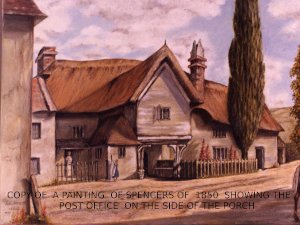
Painting of Spencer Cottage - Post office
SPENCERS COLEFORD
Most people are familiar with various guide books and estate agents telling us how Charles 1st either reviewed his troops, stabled his horse or even slept in the porch at Spencers in 1644. Charles indeed passed through Coleford on July 29th 1644, having spent the previous night at Crediton and was at Bow by the night of the 29th. But who was Spencer, and why has his name remained with the property.
The will of John Spencer, who died in 1652, describes him as “Innkeeper of Coleford”, so he may have had the pleasure of serving his king with a pint under the porch!! The Spencer name lives on because around that time, the Coryton family of Cornwall had become Lords of the Manor. To make for easier identification, many small farms and tenements became known by the names of their occupants. So we had in Coleford, John BROWN’S, Henry BOLT’S, Robert GRIBBLE’S and at Colebrooke and beyond, Robert YONGE’S, Widow ROWE’S Jeremiah STADDON’S and Nicodemus PRESTON’S, to mention but a few. At that time, Spencers would probably have been a single dwelling but was gradually altered over the years until, by the early nineteenth century, it had become four small cottages.
During the nineteenth century, Miss Ann Ebbels opened a little shop to the left of the porch, including the first post office in the parish. The scene depicted here showing a person posting a letter was executed by the late Vicki Edds, a descendant of the Arscott family. It is her excellent copy of a small original watercolour by William Dawson of 1850. The Arscotts had also lived at Spencers and were mentioned in a previous edition of the Bell.
During the 1860s, Ann retired and moved away, and the post office closed and moved to Copplestone. After this, Spencers eventually became three cottages. By the turn of the twentieth century, part of what is now known as Spencer House had been leased by the Devon Constabulary and was the home of the local police constable. Most of what is now Spencer cottage became Coleford bakery with William Whitfield, the baker. When the Coryton estate was sold in June 1919, the constabulary had relocated their constable, and Mr Whitfield had died. Local mason William Tucker, a tenant at Spencers after Whitfields, purchased the block of cottages for £215. He later sold them to a Mr James Avery, and eventually, they were purchased in 1953 by a retired civil servant Mr Arthur Shaw from London. After he died in the 1970s, airline pilot Anthony Rickard bought them and converted them into today’s two dwellings.